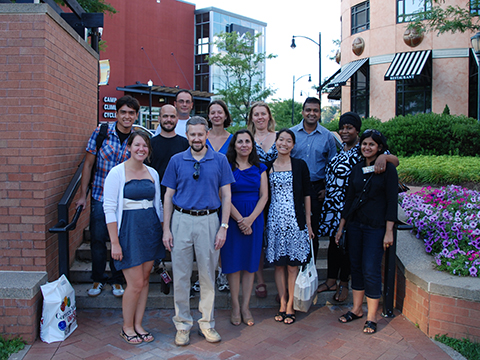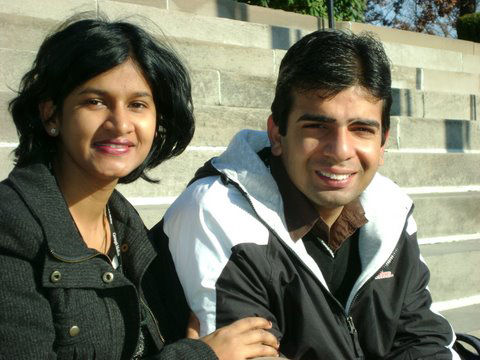Collaborators in the Lab and Life
CMU alumni Anisha Gupta and Raman Bahal design and develop precision-based therapeutics to treat cancer and other diseases
By Amy Pavlak Laird
Media Inquiries- Interim Director of Communications, MCS
- 412-268-9982
Anisha Gupta and Raman Bahal's first meeting was all about chemistry. But not that kind of chemistry — at least, not at first. The two met as undergraduates at Punjabi University, where they bonded over pharmacology and medicinal chemistry. They spent countless hours talking about the mechanism of diseases, the chemical structures of drugs and treatment regimens.
Over time, their friendship grew into something more. The couple, who earned their doctorates in Carnegie Mellon University's Department of Chemistry, married in 2008, and they still talk chemistry every day — as partners inside and outside the lab.
Bahal, an associate professor in the Department of Pharmaceutical Sciences at the University of Connecticut, and Gupta, an assistant professor of pharmaceutical sciences at the University of Saint Joseph, work at the intersection of nucleic acid chemistry and nanotechnology, designing and developing precision-based therapeutics to treat cancer and other diseases.
"We have been working together for a long time," said Bahal, who has co-authored 10 papers with Gupta. Together they have a combined publication list of nearly 80.
Their penchant for collaboration — and their interest in nucleic acid chemistry — blossomed as Ph.D. students. Bahal worked in the lab of Chemistry Professor Danith Ly, while Gupta, who joined the department one year after Bahal, worked with Bruce Armitage, professor and now head of the Department of Chemistry and co-director for the Center for Nucleic Acid Science and Technology (CNAST).
"It was an open-door policy with Danith's and Bruce's labs," Gupta said. "We had such a good collaboration there across their labs on the seventh and eighth floors of the Mellon Institute."



Ly is also a member of CNAST, an interdisciplinary community of scientists and engineers who explore the chemistry, biology, and physics of DNA, RNA, and gamma peptide nucleic acid (PNA). PNAs, synthetic nucleic acids containing the same base pairs as DNA and RNA but with a protein-like backbone, are versatile molecules that can be designed to bind to specific DNA and RNA targets inside cells to alter the expression of disease-causing genes and, ultimately, the course of disease.
With their backgrounds in pharmacy and medicinal chemistry, Bahal and Gupta recognized PNAs' therapeutic potential and dug in — first with a deep dive into PNA chemistry at Carnegie Mellon and then with an exploration of how to deliver the PNA into diseased cells at Yale University, where they worked as postdoctoral researchers.
"We collaborated with Yale's Department of Biomedical Engineering to formulate PNAs into nanoparticles, which opened up many different avenues," Gupta said. "You can change the formulation to see how the delivery changes, you can tweak the amino acid on the PNA backbone and change its chemical properties. The possibilities are limitless."
Bahal and Gupta often work hand in hand as their respective labs design and develop PNAs and other nucleic acid-based molecules to target brain cancer and lymphoma, liver disease, and stroke. Designing a PNA is only the beginning. They are also developing delivery methods to get the PNAs to the target cells and testing PNA packages in preclinical models.
"When you think about bringing a therapeutic candidate from bench to bedside, there are a lot of components there: disease biology, chemistry, delivery," Bahal said. "With PNA chemistry, there's a lot of hidden treasure, and we're trying to find out if we can connect some of those dots."
Recently, Bahal used a modified gamma-PNA to target oncogenic DNA, a root cause of cancer. Bahal's gamma-PNA successfully inhibited the expression of the c-Myc oncogene, which is implicated in various cancers, from multiple myeloma to breast cancer. He has also discerned that PNA can be used as a combination therapy for cancer treatment. Bahal's research showed that treating brain tumors in a preclinical model with gamma-PNA first can sensitize tumors to temozolomide, which is a drug of choice for brain cancer.
He's working to patent the various gamma-PNA technologies being developed in his lab and is talking with venture capitalists to potentially license the technology or launch a startup, with the goal of bringing it to patients. For his work, he received the 2024 RNA Society Moderna Award for Biomedical Innovation in RNA, the 2023 Oligonucleotide Therapeutic Society Young Investigator Award, and he was recently elected a senior member of the National Academy of Inventors. Gupta's work was also recently recognized with the 2022 American Association of Colleges of Pharmacy New Investigator Award.
Finding a good therapy that can increase a patient's life or their quality of life has been driving force for Bahal and Gupta since their undergraduate days. Initially, they planned to work in the pharmaceutical industry, but they credit Armitage and Ly for motivating them to consider academia.
"I feel so lucky to have had such close mentoring — the time that both professors would invest in their students and how they would sit down and talk to us and coach us," Gupta said.
Bahal agreed.
"We were international students. We came from India, leaving our families behind," Bahal added. "Danith and Bruce were so supportive. Even now, when we meet Bruce or Danithat a conference or somewhere, it feels like meeting someone from home."
With two young children at home, dinner-table conversations these days tend to revolve more around what's happening in elementary and middle school. That's not to say that Bahal and Gupta still don't talk shop.
"DNA and PNA are two words that my daughter picked up when she was little," Gupta said.
"I was a little concerned," Bahal joked. "She should probably start with ABC first rather than going directly to DNA."
It may turn out that chemistry is a true family affair.